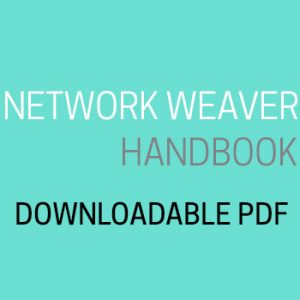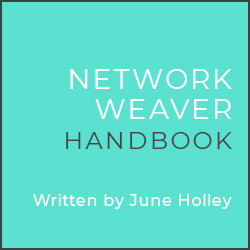The Network Weaver Handbook is a practical guide for people interested in catalyzing a new network or enhancing an existing one. Each chapter contains a short section describing key concepts, case studies, and many activities. Following each chapter is a resource section with readings, handouts, checklists, and worksheets — which you can easily duplicate and hand out to people in your network. 398 pages.
TABLE OF CONTENTS
INTRODUCTION
Why Networks? 8
Does a Network Approach Make a Difference? 12
How to Use This Handbook 13
PART 1. UNDERSTANDING NETWORKS
CHAPTER 1. STARTING WITH NETWORKS
Section 1. Networks Basics 16
Section 2. Using the Social Web to Support You and Your Network 24
Reflections on Starting with Networks 27
CHAPTER 2. NETWORK LEADERSHIP
Section 1. Leadership Roles in Networks 29
Section 2. You are a Network Weaver 39
Section 3. Network Weavers Work Together 40
Network Weaver Checklist 43
Network Weaver Roles 45
Catalyzing Networks 47
What Network? 48
How Will We Work Together? 49
Reflections on Network Leadership 50
CHAPTER 3. HOW TO INTRODUCE A NETWORK APPROACH TO OTHERS
Section 1: How Networks Are Different 51
Section 2. How Do We Share What We Know? 55
Section 3. Using the Social Web to Make the Case for Networks 56
Why Networks? 58
Why Networks? (2) 60
When a Network Lens Is Useful 61
Organization – Network 62
Combining Organizational and Network Approaches 63
Thoughts about Introducing a Network Approach 65
PART 2. IMPROVING YOUR RELATIONSHIP NETWORK
CHAPTER 4. ANALYZIG AND VISUALIZING YOUR NETWORK
Section 1: The Relationship Network 68
Section 2: Network Mapping 69
Section 3: Getting Ready to Analyze Network Maps 71
Section 4: Assessing Your Network 75
Options for Mapping 78
Practice Analyzing a Map 79
Map Your Network 81
Questions for Analysis 82
Analyzing Maps 83
Steps to A Healthier 88
Network Map 88
Characteristics of a Healthy Network 91
Assessing Your Network 92
Priorities for Your Network 95
Moving To Action 96
Thoughts on Visualizing and Assessing Your Network 100
CHAPTER 5. CONNECTING TO INCREASE THE EFFECTIVENESS OF YOUR NETWORK
Section 1. What is a Network Connector? 101
Section 2. Listening to Connect 102
Section 3. Closing Triangles 103
Section 4. Helping Others Learn to Close Triangles 104
Section 5. Adding New People to the Network 105
A Network Connector Story 108
Visualizing Your Personal Network 110
My Network Connector Plan 111
Listening to Connect 112
Identifying Potential Triangles 113
Twosies Checklist 114
Closing Triangles (from Jack Ricchiuto) 115
Closing Triangles 116
Expanding Your Periphery 117
Who is Missing? 118
Connecting Clusters Worksheet 119
Thoughts about Increasing the Effectiveness of Connections 120
CHAPTER 6. CREATING A NETWORK CULTURE
Section 1. Network Values 121
Section 2. Network Behaviors 123
Network Values Checklist 129
Awareness Activities 130
Opportunity-seeking 131
Appreciation 132
Accurate Assessment 133
What can I give? 134
Thoughts about Building the Network Culture 135
CHAPTER 7. ENGAGING YOUR NETWORK
Section 1. Interacting in New Ways 136
Section 2. Increasing Participation through Engagement 137
Section 3. Engaging Difference 139
Section 4. Deep Reflection, Everywhere, All the Time 140
Appreciative Interviews 142
Increasing Participation Through Engagement 143
Bringing Together Difference for Better Outcomes 144
Questions to Ask That Lead to Deep Reflection 145
Sample Reflection Ideas 146
Thoughts about Engaging Your Network 147
CHAPTER 8. TRUST IN NETWORKS
Section 1. Understanding Trust 148
Section 2. Assessing Levels of Trust 149
Discussion on Trust 151
Creating a Culture of Trust 152
Trust and Networks: How Can We Go Deeper? 156
Network Trust Assessment 165
Sharing Strengths and Challenges: 167
Personal Trust Assessment 167
Thoughts about Trust in Networks 169
PART 3. MOVING TO ACTION
CHAPTER 9. SELF_ORGANIZING
Section 1. Understanding Self-organizing 172
Section 2. Moving to self-organizing 179
Section 3. Integration and Reflection 181
Section 4. Project Coordination 181
Section 5. Coaching Project Coordinators 183
Section 6. Social Web Platforms to Support Project Coordination 184
Section 7. Using Social Web Platforms to Support Other Self-organization 186
Self-organized Projects 189
Opportunity Process 190
Project Coordination 191
Project Coordinator Role 192
Ground Rules for Small Groups 193
What Do Project Coordinators Need to Think About? 194
Project Coordinator Coach 195
Thoughts about Self-Organizing 196
CHAPTER 10. FROM INNOVATION TO TRANSFORMATION
Section 1. How Do Networks Lead to Transformation? 198
Section 2. Creating a local innovation ecosystem 199
Section 3. Leadership for Innovation 209
The End of Footbinding in China as an Example of the Power of Networks 212
Innovation Asset Assessment 214
Identifying Innovators 216
Network Transformation 217
Learning from Small Experiments 218
Thoughts about Innovation in Networks 219
PART 4. INTENTIONAL NETWORKS
CHAPTER 11. INTENTIONAL NETWORK BASICS
Section 1. Definitions and History 222
Section 2. Identifying your Intentional Network 231
Section 3. Leadership in Intentional Networks 237
Section 3. Network Elements 238
Network Focal Point 240
Network Function Assessment 241
Your Network Needs to Decide… 244
Thoughts about Intentional Network Basics 246
CHAPTER 12. FORMING A NEW NETWORK
Section 1. Introduction 247
Section 2. Forming a Network 248
Section 3. Steps in Organizing Your Network 248
Forming A New Network: Are We Ready? 257
Network Interest Tracking 258
Map Drawing Activity for New Networks 259
Sample Cooperative Agreements 260
Thoughts about Starting a New Intentional Network 263
CHAPTER 13. TUNE-UP FOR AN EXISTING NETWORK
Section 1. Coordinating the tune-up process 264
Section 2. Assessing Your Network 265
Section 3. Tune-up 265
Assessing Your Current Issue Strategy 271
Relationship Building 272
Thoughts about Tuning Up an Intentional Network 273
PART 5. SUPPORTING NETWORKS
CHAPTER 14. CREATING AN ENABLING ENVIRONMENT FOR YOUR NETWORK
Section 1. Role of the Network Guardian 277
Section 2. Systems to Support Networking and Communication 277
Section 2. A System for Resource Flow 284
Section 3. Designing a Network Support System 287
Personal Communication Assessment 289
Using Social Media to Support Your Network 290
Current communication ecosystem 293
Your Network Communication Strategy 294
Resource Pool 295
Assessment of Your Network’s Support System 296
Ideas for a Support System for Your Network 298
Designing the Network System of Support 300
Thoughts about Network Support Systems 301
CHAPTER 15. NETWORK WEAVER SUPPORTS SYSTEMS
Section 1. Network Weaver Roles 302
Section 2. A Support System for Network Weavers 304
Section 3. Training Network Weavers 304
Section 4. Coaching Network Weavers 305
Section 5. Communities of Practice 306
15 Steps to Incubate Network Weavers 311
Sandboxes 313
Wisdom of the Crowd 314
Coaching Sessions 315
Freeing Up Your Time 316
Tracking Priorities 317
Thoughts on Network Weaver Support Systems 318
PART 6. NETWORK STRATEGY
CHAPTER 16. DEVELOPING YOUR NETWORK STRATEGY
Section 2. The Strategy Development Process 321
Section 2. Four System Change Processes 326
Section 3. Transformative networks are multiscalar 329
Drawing Your System 341
Network Evaluation 342
Network Indicators 345
Collective Sensemaking 346
Thoughts about Network Strategy 347
CONCLUSION
APPENDICES
Appendix 1. Building Communities Through Network Weaving 350
Appendix 2. Networks, Self-Organizing, Breakthroughs and Scale: A Case Study 359
Appendix 3. Glossary of Network Terms 371
Appendix 4. Quotes 375
Appendix 5. Bibliography 376
INDEX 381



Reviews
There are no reviews yet.